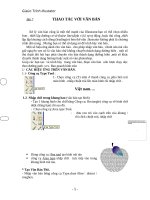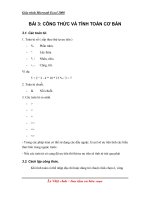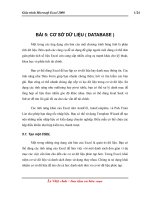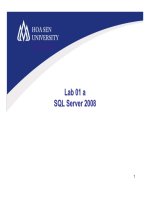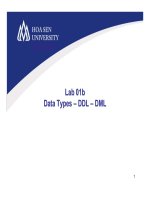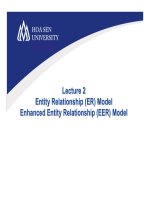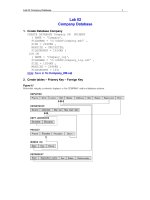Giáo trình SQL bài 17
Bạn đang xem bản rút gọn của tài liệu. Xem và tải ngay bản đầy đủ của tài liệu tại đây (209.25 KB, 26 trang )
Lecture 8
SQL 3 – DML
Objectives
• INSERT, UPDATE and DELETE statements
• Assertions and Triggers
• Views
• Reference: Chapter 8
Faculty of Science and Technology
Database Fundamentals
2
Specifying Updates in SQL
• There are three SQL commands to modify the
database:
INSERT
DELETE
UPDATE
Faculty of Science and Technology
Database Fundamentals
3
INSERT
• In its simplest form, it is used to add one or more
tuples to a relation
• Attribute values should be listed in the same
order as the attributes were specified in the
CREATE TABLE command
Faculty of Science and Technology
Database Fundamentals
4
INSERT (2)
• Example:
U1:INSERT INTO EMPLOYEE
VALUES ('Richard','K','Marini',
'653298653', '30-DEC-52', '98 Oak
Forest,Katy,TX', 'M', 37000,'987654321', 4 )
• An alternate form of INSERT specifies explicitly the
attribute names that correspond to the values in the new
tuple
Attributes with NULL values can be left out
• Example: Insert a tuple for a new EMPLOYEE for whom
we only know the FNAME, LNAME, and SSN attributes.
U1A: INSERT INTO EMPLOYEE (Fname, Lname, Ssn)
VALUES ('Richard', 'Marini','653298653')
Faculty of Science and Technology
Database Fundamentals
5
INSERT (3)
• Important Note: Only the constraints specified in
the DDL commands are automatically enforced
by the DBMS when updates are applied to the
database
Another variation of INSERT allows insertion of
multiple tuples resulting from a query into a
relation
Faculty of Science and Technology
Database Fundamentals
6
INSERT (4)
• Example: Suppose we want to create a temporary table that has the
name, number of employees, and total salaries for each department.
A table DEPTS_INFO is created by U3A, and is loaded with the
summary information retrieved from the database by the query in
U3B.
U3A: CREATE TABLE DEPTS_INFO
(Dept_name VARCHAR(10),
No_of_emps INTEGER,
Total_sal INTEGER);
U3B:
INSERT INTO DEPTS_INFO (Dept_name, No_of_emps,
Total_sal)
SELECT
Dname, COUNT (*), SUM (Salary)
FROM
DEPARTMENT, EMPLOYEE
WHERE
Dnumber=Dno
GROUP BY
Dname ;
Faculty of Science and Technology
Database Fundamentals
7
INSERT (5)
• Note: The DEPTS_INFO table may not be up-todate if we change the tuples in either the
DEPARTMENT or the EMPLOYEE relations
after issuing U3B. We have to create a view
(see later) to keep such a table up to date.
Faculty of Science and Technology
Database Fundamentals
8
DELETE
• Removes tuples from a relation
Includes a WHERE-clause to select the tuples to be
deleted
Referential integrity should be enforced
Tuples are deleted from only one table at a time (unless
CASCADE is specified on a referential integrity constraint)
A missing WHERE-clause specifies that all tuples in the
relation are to be deleted; the table then becomes an
empty table
The number of tuples deleted depends on the number of
tuples in the relation that satisfy the WHERE-clause
Faculty of Science and Technology
Database Fundamentals
9
DELETE (2)
• Examples:
U4A: DELETE FROM EMPLOYEE
WHERE
Lname='Brown’
U4B: DELETE FROM EMPLOYEE
WHERE
Ssn='123456789’
U4C: DELETE FROM EMPLOYEE
WHERE DNO IN
(SELECT
Dnumber
FROM
DEPARTMENT
WHERE
Dname='Research')
U4D: DELETE FROM EMPLOYEE
Faculty of Science and Technology
Database Fundamentals
10
UPDATE
• Used to modify attribute values of one or more
selected tuples
• A WHERE-clause selects the tuples to be
modified
• An additional SET-clause specifies the attributes
to be modified and their new values
• Each command modifies tuples in the same
relation
• Referential integrity should be enforced
Faculty of Science and Technology
Database Fundamentals
11
UPDATE (2)
• Example: Change the location and controlling
department number of project number 10 to
'Bellaire' and 5, respectively.
U5: UPDATE
SET
WHERE
Faculty of Science and Technology
PROJECT
Plocation = 'Bellaire',
Dnum = 5
Pnumber=10
Database Fundamentals
12
UPDATE (3)
• Example: Give all employees in the 'Research'
department a 10% raise in salary.
U6:UPDATE
SET
WHERE Dno
EMPLOYEE
Salary = Salary *1.1
IN (SELECT Dnumber
FROM DEPARTMENT
WHERE Dname='Research')
• In this request, the modified SALARY value depends on
the original SALARY value in each tuple
The reference to the SALARY attribute on the right of =
refers to the old SALARY value before modification
The reference to the SALARY attribute on the left of =
refers to the new SALARY value after modification
Faculty of Science and Technology
Database Fundamentals
13
Constraints as Assertions
•
•
General constraints: constraints that do not fit
in the basic SQL categories
Mechanism: CREAT ASSERTION
Components include:
•
•
•
a constraint name,
followed by CHECK,
followed by a condition
Faculty of Science and Technology
Database Fundamentals
14
Assertions: An Example
• “The salary of an employee must not be greater
than the salary of the manager of the
department that the employee works for’’
Constraint name
CREAT ASSERTION SALARY_CONSTRAINT
CHECK (NOT EXISTS (SELECT *
FROM EMPLOYEE E, EMPLOYEE M,
Key
word
DEPARTMENT D
WHERE E.Salary > M.salary AND
E.Dno=D.Number AND
D.Mgr_ssn=M.Ssn))
Condition
Faculty of Science and Technology
Database Fundamentals
15
Using General Assertions
• Specify a query that violates the condition;
include inside a NOT EXISTS clause
• Query result must be empty
if the query result is not empty, the assertion has
been violated
Faculty of Science and Technology
Database Fundamentals
16
SQL Triggers
• Objective: to monitor a database and take
initiate action when a condition occurs
• Triggers are expressed in a syntax similar to
assertions and include the following:
Event
• Such as an insert, deleted, or update operation
Condition
Action
• To be taken when the condition is satisfied
Faculty of Science and Technology
Database Fundamentals
17
SQL Triggers: An Example
• A trigger to compare an employee’s salary to his/her
supervisor during insert or update operations:
CREATE TRIGGER INFORM_SUPERVISOR
BEFORE INSERT OR UPDATE OF
SALARY, SUPERVISOR_SSN ON EMPLOYEE
FOR EACH ROW
WHEN
(NEW.Salary> (SELECT Salary FROM EMPLOYEE
WHERE Ssn=NEW.Supervisor_ssn))
INFORM_SUPERVISOR
(NEW.Supervisor_ssn,NEW.Ssn);
Faculty of Science and Technology
Database Fundamentals
18
Views in SQL
• A view is a “virtual” table that is derived from
other tables
• Allows for limited update operations
Since the table may not physically be stored
• Allows full query operations
• A convenience for expressing certain operations
Faculty of Science and Technology
Database Fundamentals
19
Specification of Views
• SQL command: CREATE VIEW
a table (view) name
a possible list of attribute names (for example,
when arithmetic operations are specified or when
we want the names to be different from the
attributes in the base relations)
a query to specify the table contents
Faculty of Science and Technology
Database Fundamentals
20
SQL Views: An Example
• Specify a different WORKS_ON table
CREATE VIEW WORKS_ON_NEW AS
SELECT Fname, Lname, Pname, Hours
FROM EMPLOYEE, PROJECT, WORKS_ON
WHERE Ssn=Essn AND Pno=Pnumber
GROUP BY Pname;
Faculty of Science and Technology
Database Fundamentals
21
Using a Virtual Table
• We can specify SQL queries on a newly create
table (view):
SELECT Fname, Lname
FROM WORKS_ON_NEW
WHERE Pname=‘Seena’;
• When no longer needed, a view can be dropped:
DROP WORKS_ON_NEW;
Faculty of Science and Technology
Database Fundamentals
22
Efficient View Implementation
• Query modification:
Present the view query in terms of a query on the
underlying base tables
• Disadvantage:
Inefficient for views defined via complex queries
• Especially if additional queries are to be applied to
the view within a short time period
Faculty of Science and Technology
Database Fundamentals
23
Efficient View Implementation
• View materialization:
Involves physically creating and keeping a
temporary table
• Assumption:
Other queries on the view will follow
• Concerns:
Maintaining correspondence between the base
table and the view when the base table is
updated
• Strategy:
Incremental update
Faculty of Science and Technology
Database Fundamentals
24
Update Views
• Update on a single view without aggregate
operations:
Update may map to an update on the underlying
base table
• Views involving joins:
An update may map to an update on the
underlying base relations
• Not always possible
Faculty of Science and Technology
Database Fundamentals
25

